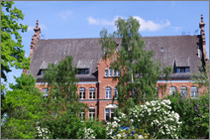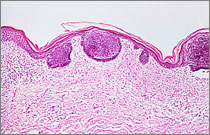Breast cancer
| 2022 | ||
|---|---|---|
¹ per 100,000 persons, age-standardised according to the old European standard population * until 1.12.2020 ** calculated using the period method for 2019 / 2020 | ||
| Women | Men | |
| Incidence | 74,512 | 694 |
| Age-standardised incidence rate¹ | 117.5 | 1.0 |
| Deaths 2023 | 18,527 | 186 |
| Age-standardised mortality rate¹ | 21.0 | 0.3 |
| 5-year prevalence* | 315,000 | 2,800 |
| 10-year prevalence* | 570,900 | 4,600 |
| Relative 5-year survival rate** | 88 % | 77 % |
| Relative 10-year survival rate** | 83 % | 68 % |
With approximately 74,500 annual incident cases, breast cancer is by far the most common cancer in women. In addition, more than 6,000 women are diagnosed with an in situ breast tumour every year. About 1 percent of all new cases of breast cancer affect men.
Based on current incidence rates, about one in eight women is expected develop breast cancer over the course of a lifetime. Almost one out of six affected women are below 55 years of age at diagnosis. Rates of new cases and deaths remain lower in former East German states than in former West German ones; only for women below 55 years of age have the rates largely converged.
What is the effect of mammography screening?
Following the introduction of mammography screening between 2005 and 2009, the rates of new cases show a typical trend with a significant increase at the beginning of the program and a subsequent slow decline. It was shown that fewer women in the screening age group were diagnosed with advanced tumors than before the introduction of screening.
Since the end of the 1990s, breast cancer mortality rates have been falling continuously, most recently most sharply among women aged between 60 and 69.

![]() Estimated age-standardised incidence rates of breast cancer in women eligible for mammography screening (50 - 69 years old) and other age groups (30 - 49 years old, 70 years and older), Germany 1999 - 2018, per 100,000 women (old European standard population)
Estimated age-standardised incidence rates of breast cancer in women eligible for mammography screening (50 - 69 years old) and other age groups (30 - 49 years old, 70 years and older), Germany 1999 - 2018, per 100,000 women (old European standard population)
Progress in therapy has substantially improved the survival chances of people diagnosed with breast cancer, and this has led to a decrease in mortality rates as well. Within a few years’ time, it should be possible to assess the extent to which screening has brought about a further reduction.
Hormones influence the risk of breast cancer
Hormones can influence the risk of disease: Early first and late last menstruation, childlessness or a higher age at first birth are considered risk factors. Hormone replacement therapy can increase the risk of breast cancer, especially prolonged, combined oestrogen-progestin therapy. Ovulation inhibitors containing hormones (birth control pills) increase breast cancer risk slightly.
Very dense breast tissue, certain benign breast changes or a previous history of breast cancer are also among known breast cancer risk factors.
Some breast cancers are due to an increased genetic risk: Women whose close relatives have been diagnosed with breast or ovarian cancer have an elevated risk of developing breast cancer themselves. Similarly, the risk of breast cancer increases after radiotherapy of the breast during childhood or adolescence.
Lifestyle factors such as overweight and lack of exercise after menopause as well as alcohol consumption are also risk factors. Smoking could also slightly increase risk.
What screening tests are available?
The early detection programme of the statutory health insurance offers women 30 years of age and over an annual palpation examination by a physician. Women between the ages of 50 and 75 years are entitled to an X-ray examination of the breast every two years as part of the mammography screening programme.
Date: 20.11.2024






